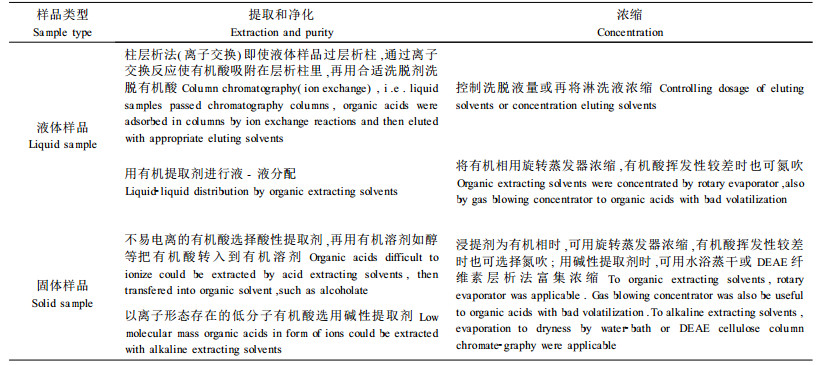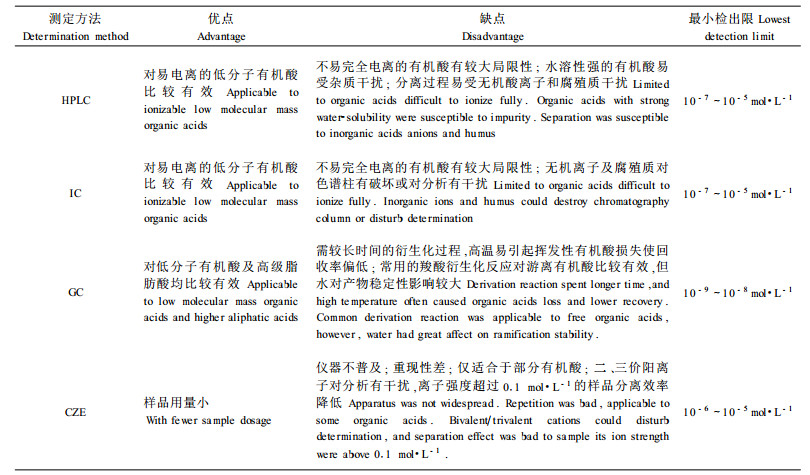文章信息
- 宋金凤, 崔晓阳.
- Song Jinfeng, Cui Xiaoyang.
- 森林土壤中低分子有机酸研究进展
- Advanc in Studyof Low Molecular Mass Organic Acids in Forest Soils
- 林业科学, 2008, 44(6): 118-124.
- Scientia Silvae Sinicae, 2008, 44(6): 118-124.
-
文章历史
- 收稿日期:2006-08-21
- 修回日期:2008-04-28
-
作者相关文章
有机酸是森林土壤和凋落物层普遍存在的一类功能性有机物,一般指低分子有机酸,由于具有特殊的分子结构和荷电特性,已成为国内外森林土壤学、植物营养学及生态学等多学科研究的热点(Wu et al., 2003)。有机酸是土壤中碳的最活跃形式,能通过螯合和配位体交换等复杂机制影响森林土壤的化学和生物学过程,对森林土壤的形成演变、植物根际矿质养分的有效性、酸性土壤铝毒缓解及重金属活性等多种土壤过程产生深刻影响(El-Tayeb et al., 2006;Srivastava et al., 2007),还强烈影响植物的多种生理生态过程,调节植物对环境的适应及对不良环境的抗性(Pramod et al., 2000)。
鉴于有机酸重要的生态功能,森林土壤中有机酸的来源、物质的量浓度、转化及分析测定等基础研究工作非常重要,国内外学者曾对上述几方面内容进行过研究探讨,本文从国内外有机酸的研究热点出发,综述了近年来森林土壤中有机酸的种类、来源、转化、物质的量浓度等研究进展,同时还对有机酸的提取、纯化、浓缩、测定等进行探讨,为科学评价有机酸在森林生态系统的重要意义提供理论指导。
1 森林土壤中有机酸的种类与来源有机酸在森林生态系统普遍存在,主要包括脂肪族和芳香族2大类(Shen et al., 1996),国内外学者已从不同的林地土壤和森林凋落物中检测出近40种有机酸(表 1),其中草酸、柠檬酸等低分子有机酸较多(Fox et al., 1990;Song et al., 2003)。低分子有机酸为弱酸,含1~3个羧基,在森林土壤溶液总可溶性有机碳中所占比例常低于3%(Hees et al., 2002),但由于有机酸具有特殊的化学结构和荷电特性,在森林生态系统中亦发挥着重要作用。
|
|
土壤中有机酸主要来源于残体有机质分解、根分泌作用及微生物分泌(Devêvre et al., 1996;Sandnes et al., 2005),对森林土壤而言,大量凋落物的分解和淋溶过程是森林生态系统中有机酸的重要来源,不同树种凋落物在其初期化学分解和随后的微生物分解转化过程中不断释放出各种有机酸(表 2)(Whitehead et al., 1983;Pohlman et al., 1988;Fox et al., 1990;Krzyszowska et al., 1996;Lundström et al., 2000;Nardi et al., 2003;Song et al., 2003;莫淑勋,1986;宋金凤等,2004)。除低分子有机酸外,森林凋落物还产生高级脂肪酸,这些有机酸随淋溶作用进入土壤,从而对土壤产生深刻影响。森林土壤中有机酸的产生直接与森林土壤微生物的数量和活性相联系,并与植被、凋落物数量和组成、土壤类型等因素密切相关(Strobel, 2001)。
|
|
有机酸发挥作用的程度不仅取决于有机酸的种类和数量,还与其转化息息相关。有机酸释放后即处于动态转化过程中,包括被微生物降解、被土壤固相吸附及被金属络合吸附等(Boddy et al., 2007)。
2.1 微生物降解有机酸释放后迅速被微生物分解利用,途径有脱羧和氧化2种(McCollom et al., 2003),低分子有机酸易被降解,长链脂肪酸溶解度小所以较稳定。有机酸的降解速率与土壤性质和有机酸种类有关,一般表层土壤降解速率较高,且大多数土层柠檬酸和草酸的降解速率高于乙酸(Jones et al., 2001;Hees et al., 2002)。释放一定时间后,由于土壤液相中可被微生物利用的有机酸耗尽,有机酸降解速率渐趋稳定。
2.2 土壤固相吸附有机酸对一些矿物表面有较强的亲和性(Christofaro et al., 2000),可通过静电作用被粘土矿物和腐殖质等土壤矿质颗粒吸附。在有机酸浓度较低或倍半氧化物物质的量浓度较高的土壤中,吸附在维持有机酸浓度方面起重要的缓冲作用(Jones et al., 1998b)。有机酸释放后吸附便迅速产生,其程度与有机酸种类和土壤性质有关:与单羧酸相比,二-羧酸、三-羧酸更易被土壤固相吸附,尤其在Fe、Al氢氧化物丰富的底层土中;瑞典Nyänget、Heden、Delamere等地区B层灰壤对有机酸的吸附强于O层和E层,含铁水化氧化物和原生伊毛缟石是主要的吸附基质(Hees et al., 2003);砖红壤对有机酸的吸附为柠檬酸>草酸>醋酸,氧化铁是主要吸附载体(徐仁扣等,2004),但Ah层石灰性土对草酸的吸附强度高于柠檬酸和苹果酸(Jones et al., 1998b)。另外,有机酸的吸附明显降低其生物降解率,吸附越强生物降解越弱,这导致灰化土(Jones et al., 2001)和灰化针叶林土(Hees et al., 2002)表层有机酸降解强于下层。
2.3 金属络合吸附有机酸还能与土壤中Fe、Al、Ca多种金属离子形成络合物而吸附。与土壤固相吸附相比,络合吸附生态意义更大,影响土壤中P、Fe、Pb、As等元素的有效性,如草酸通过对暗棕壤中铁铝氧化物表面和铁、铝、钙磷酸盐的络合溶解,促进暗棕壤磷的释放,东北林业大学老爷岭生态站森林凋落物溶出的草酸,能促进A1层暗棕壤磷释放2.40 kg·hm-2a-1,约相当于中龄林年吸收磷量的1/3~1/5(崔晓阳等,2005)。有机酸也络溶土壤中难溶性铁氧化物,少量草酸就可将铁的溶解度提高几个数量级(Schwertmann, 1991),同时还与重金属形成可溶性络合物而影响Cd、Pb、As等元素的有效性(张敬锁等,1999)。
3 有机酸物质的量浓度森林土壤中的有机酸处于合成和降解的动态循环中,物质的量浓度是其合成及降解过程的平衡浓度(Hees et al., 2003)。森林土壤中有机酸物质的量浓度与土壤类型、深度及植被类型等因素密切相关,通常在10-6~10-3mol范围内,O和A层含量高于B层,其中单羧酸(如甲酸、乙酸)含量较高,一般>50 μmol·L-1,有的甚至达1.0 mmol·L-1,针叶森林土壤中更高,如挪威云杉(Picea abies)森林土壤中甲酸、乙酸、丙酸含量分别达415、1 267和403 μmol·L-1;二/三羧酸(如草酸、苹果酸、柠檬酸)含量较低,通常<50 μmol·L-1,最高仅100 μmol·L-1左右(Strobel, 2001;Nardi et al., 2003)。森林土壤中有机酸含量还与微生物活性有关,林木根系向根际分泌有机酸,促进了根际微生物大量繁殖,反过来又使有机酸分泌增加,致使根际土壤有机酸含量明显高于非根际土壤(Jones,1998;Hu et al., 2001)。
4 有机酸的分析测定分析测定样品中的有机酸,首先要进行样品前处理,再根据不同要求选择合适的测定方法,森林土壤和凋落物样品亦如此。
4.1 样品前处理样品前处理包括提取(萃取)、净化、浓缩等过程,首先要将被测物质预先从复杂的样品基体中提取、分离出来,试验要求和目的不同提取方式也不同(表 3)。液体样品前处理较简单;对于固体样品中有机酸的前处理,提取剂的选择非常重要,按pH值分,低分子有机酸的提取剂有酸性、中性和碱性,应用较多的有0.25或0.5 mol·L-1 H2SO4、去离子水、乙醇、碱性乙醇(pH 11)等(莫淑勋,1986;宋金凤等,2004)。对于同一样品,提取剂种类不同有机酸的提取效果也不同:测定土壤时,通常去离子水能使浸提过程中土壤的化学变化降至最低(Blum et al., 1994);与水相比,80%醇类提取草酸完全,又使样品中蛋白质变性沉淀,有利于延长色谱法测定时色谱柱的使用寿命(李连朝等,1989);对于结合态有机酸多的样品,温水的提取效率高于醇(鲍士旦,2000)。对于干扰较多的提取液,也可选择固相萃取(SPE)和固相微萃取(SPME)等方法进一步净化,如Casey等(1998)使用Bond Elut SAX, Sep-Pak C18 SPE柱去除种子浸出液中的蛋白质和有机物,用CarboPac PA1分离柱测定了种子浸出液中的有机酸;Kuo(1998)还采用OnGuard RP作SPE柱去除阳离子,用IonPac AS11柱分离测定了饮用水中的羧酸。
|
|
森林土壤或凋落物中有机酸含量通常很低,进样分析前有时需要浓缩处理,常用的浓缩方法包括旋转蒸发器浓缩、氮吹、冷冻干燥、水浴蒸干及DEAE纤维素层析法富集浓缩等,应根据不同的样品处理过程进行合理选择(表 3)。
4.2 有机酸测定传统上常采用化学方法测定有机酸,但通常仅能测定总酸量,且误差较大,极谱法、纸色谱法和薄层色谱法等在准确度、重现性或定量分析方面存在一定弊端(莫淑勋,1986)。随着色谱技术发展,上述几种方法的应用逐渐减少,目前有机酸的测定主要采用高效液相色谱法(紫外检测器)(HPLC)、离子色谱法(IC)、气相色谱法(GC)(氢火焰离子化检测器)及毛细管电泳法(CZE)等(表 4)(Krzyszowska et al., 1996;Strobel et al., 1999;俞乐等,2002)。
|
|
随着强极性毛细管柱及快速色谱的开发和应用,有机酸的直接测定成为可能,一些有机酸可不经衍生化直接进行气相色谱法分析(莫淑勋,1986;Yang et al., 2001)。但大多数样品中的有机酸不完全以游离态存在,往往还有以甘油酸脂、酯类等分子形式存在的有机酸,这些物质不易气化或不以单一形态存在,如直接测定需皂化等处理过程;一些高碳数有机酸的测定效果也不理想,因此直接进样法测定有机酸还有待于进一步研究,目前气相色谱法测定有机酸仍以衍生化法为主(Chen et al., 1998)。还有人用高效液相色谱法直接测定液体样品中有机酸,但此法对高碳数有机酸局限性较大,且水溶性强的有机酸易受杂质干扰,如甲酸、乙酸等。总之,有机酸的提取、浓缩、测定方法很多,具体操作时应根据试验条件、需要和目的进行合理选择。
5 研究展望森林土壤中有机酸的研究还有几方面亟待加强:如系统研究我国主要林区森林土壤、凋落物、林木根系分泌物中有机酸的种类和数量动态,特别是不同林木在营养胁迫条件下分泌有机酸的种类和数量、有机酸在林木根际的积累效应;各种有机酸在森林土壤中的降解、吸附强度和空间变异规律;有机酸对林木生长发育、生物量分配及各种生理生态过程的影响及机制,有机酸对林木吸收、运输各种营养元素的影响和机理;某些有机酸还能激活植物一系列抗性防卫反应,增强对不良环境的适应性,目前已有一些水杨酸能提高农作物抗病、抗盐、抗冷、抗热、抗旱、抗机械伤害等能力的报道(孙艳等,2003),但有机酸对提高苗木抗逆性的报道还很少见。
鲍士旦. 2000. 土壤农化分析. 北京: 中国农业出版社.
|
崔晓阳, 宋金凤. 2005. 草酸/草酸盐对森林暗棕壤的磷释放效应. 土壤学报, 42(6): 977-984. DOI:10.3321/j.issn:0564-3929.2005.06.015 |
李连朝, 李天荣, 汪沛洪. 1989. 反相HPLC测定食物中的有机酸. 分析测试通报, 8(3): 21-26. |
莫淑勋. 1986. 土壤中有机酸的产生、转化及对土壤肥力的某些影响. 土壤学进展, (4): 1-10. |
宋金凤, 刘永, 崔晓阳. 2004. 毛细管气相色谱法测定森林凋落物中的有机酸. 林业科学, 40(4): 186-188. DOI:10.3969/j.issn.1006-1126.2004.04.006 |
孙艳, 王鹏. 2003. 水杨酸对黄瓜幼苗抗高温胁迫能力的影响. 西北植物学报, 23(11): 2011-2013. DOI:10.3321/j.issn:1000-4025.2003.11.031 |
王立, 汪正范, 牟世芬, 等. 2001. 色谱分析样品处理. 北京: 化学工业出版社.
|
徐仁扣, 钱薇, 李九玉. 2004. 砖红壤吸附低分子量有机酸的初步研究. 土壤, 36(4): 446-448. DOI:10.3321/j.issn:0253-9829.2004.04.022 |
俞乐, 彭新湘, 杨崇, 等. 2002. 反相高效液相色谱法测定植物组织及根分泌物中草酸. 分析化学, 30(9): 1119-1122. DOI:10.3321/j.issn:0253-3820.2002.09.027 |
张敬锁, 李花粉, 衣纯真, 等. 1999. 有机酸对活化土壤中镉和小麦吸收镉的影响. 土壤学报, 36(1): 61-66. DOI:10.3321/j.issn:0564-3929.1999.01.009 |
Blum U, Worsham A D, King L D, et al. 1994. Use of water and EDTA extractions to estimate available(free and reversibly bound) phenolic acids in Cecil soils. Journal of Chemical Ecology, 20: 341-359. DOI:10.1007/BF02064442 |
Boddy E, Hill P W, Farrar J, et al. 2007. Fast turnover of low molecular weight components of the dissolved organic carbon pool of temperate grassland field soils. Soil Biology & Biochemistry, 39: 827-835. |
Casey C E, O′Sullivan O B, O′Gara F, et al. 1998. Ion chromatographic analysis of nutrients in seed exudate for microbial colonisation. Journal of Chromato-graphy A, 804: 311-318. DOI:10.1016/S0021-9673(97)01297-1 |
Chen Z L, Landman P, Colmer T D, et al. 1998. Simultaneous analysis of amino and organic acids in extracts of plant leaves as tertbutyl-dimethylsilyl derivatives by capillary gas chromatography. Analytical Biochemistry, 259: 203-211. DOI:10.1006/abio.1998.2659 |
Christofaro A D, He J Z, Zhou D H, et al. 2000. Adsorption of phosphate and tartrate on hydroxy-aluminium-oxalate precipitates. Soil Science Society of America Journal, 64: 1347-1355. DOI:10.2136/sssaj2000.6441347x |
Devêvre O, Garnaye J, Botton B. 1996. Release of complexing organic acids by rhizosphere fungi as a factor in Norway spruce yellowing in acidic soils. Mycological Research, 100: 1367-1374. DOI:10.1016/S0953-7562(96)80065-7 |
El-Tayeb M A, El-Enany A E, Ahmed N L. 2006. Salicylic acid-induced adaptive response to copper stress in sunflower(Helianthus annuus L.). Plant Growth Regulation, 50: 191-199. DOI:10.1007/s10725-006-9118-2 |
Fox T R, Comerford N B. 1990. Low-molecular-weight organic acids in selected forest soils of the southeastern USA. Soil Science Society of America Journal, 54: 1139-1144. DOI:10.2136/sssaj1990.03615995005400040037x |
Hees P A W van, Jones D L, Godbold D L. 2002. Biodegradation of low molecular weight organic acids in coniferous forest podzolic soils. Soil Biochemistry, 34: 1261-1272. DOI:10.1016/S0038-0717(02)00068-8 |
Hees P A W van, Vinogradoff S I, Edwards A C, et al. 2003. Low molecular weight organic acids adsorption in forest soils:effects on soil solution concentrations and biodegradation rates. Soil Biology & Biochemistry, 35: 1015-1026. |
Hu H Q, He J Z, Li X Y, et al. 2001. Effect of several organic acids on phosphate adsorption by variable charge soils of central China. Environment International, 26: 353-358. DOI:10.1016/S0160-4120(01)00012-5 |
Jones D L. 1998. Organic acid in the rhizosphere-a critical review. Plant Soil, 205: 25-44. DOI:10.1023/A:1004356007312 |
Jones D L, Brassington D S. 1998. Sorption of organic acids in acid soils and its implications in the rhizosphere. European Journal of Soil Science, 49: 447-455. DOI:10.1046/j.1365-2389.1998.4930447.x |
Jones D L, Eldhuset T, de Wit H A, et al. 2001. Aluminium effects on organic mineralization in a Norway spruce forest soil. Soil Biology & Biochemistry, 33: 1259-1267. |
Krzyszowska A J, Blaylock M J, Vance G F, et al. 1996. Ion chromatographic analysis of low molecular weight organic acids in Spodosol forest floor solutions. Soil Science Society of America Journal, 60: 1565-1571. DOI:10.2136/sssaj1996.03615995006000050040x |
Kuo C. 1998. Improved application of ion chromatographic determination of carboxylic acids in ozonated drinking water. Journal of Chromatography A, 804: 265-272. DOI:10.1016/S0021-9673(98)00089-2 |
Lundström U S, Breemen N V, Bain D. 2000. The podzolization progress. A review. Geoderma, 94: 91-107. DOI:10.1016/S0016-7061(99)00036-1 |
McCollom T M, Seewald J S. 2003. Experimental study of the hydrothermal reactivity of organic acids and acid anions: Ⅱ.Acetic acid, acetate, and valeric acid. Geochimica et Cosmochimica Acta, 67(19): 3645-3664. DOI:10.1016/S0016-7037(03)00135-2 |
Nardi S, Pizzeghello D, Bragazza L, et al. 2003. Low-molecular-weight organic acids and hormone-like activity of dissolved organic matter in two forest soils in Italy. Journal of Chemical Ecology, 29(7): 1549-1564. DOI:10.1023/A:1024214528514 |
Pohlman A A, McColl J G. 1988. Soluble organics from forest litter and their role in metal dissolution. Soil Science Society of America Journal, 52: 265-271. DOI:10.2136/sssaj1988.03615995005200010047x |
Pramod K, Jyothi L N, Mani V P. 2000. Interactive effects of salicylic acid and phytohormones on phytosynthesis and grain yield of soybean(Glycine max L. Merrill). Physiology and Molecular Biology of Plants, 6: 179-186. |
Sandnes A, Eldhuset T D, Wollebæk G. 2005. Organic acids in root exudates and soil solution of Norway spruce and silver birch. Soil Biology & Biochemistry, 37: 259-269. |
Schwertmann U. 1991. Solubility and dissolution of iron oxides//Chen Y, Hadar Y. Iron nutrition and interactions in plants. Netherlands: Kluwer Academic Publishers, 3-27.
|
Shen Y, Ström L, Jönsson JÅ, et al. 1996. Low-molecular organic acids in the rhizosphere soil solution of beech forest(Fagus sylvatica L.)cambisols determined by ion chromatography using supported liquid membrane enrichment technique. Soil Biology & Biochemistry, 28(9): 1163-1169. |
Song J F, Cui X Y. 2003. Analysis of organic acids in selected forest litters of Northeast China. Journal of Forestry Research, 14(4): 285-289. DOI:10.1007/BF02857855 |
Srivastava N K, Srivastava A K. 2007. Influence of gibberellic acid on 14CO2 metabolism, growth, and production of alkaloids in Catharanthus roseus. Photosynthetica, 45(1): 156-160. DOI:10.1007/s11099-007-0026-0 |
Strobel B W, Bernhoft I, Borggaard O K. 1999. Low-molecular-weight aliphatic carboxylic acids in soil solutions under different vegetations determined by capillary zone electrophoresis. Plant Soil, 212: 115-121. DOI:10.1023/A:1004637126429 |
Strobel B W. 2001. Influence of vegetation on low-molecular-weight carboxylic acids in soil solution-a review. Geoderma, 99: 169-198. DOI:10.1016/S0016-7061(00)00102-6 |
Whitehead D C, Dibb H, Hartley R D. 1983. Bound phenolic compounds in water extracted of soil, plant roots and leaf litter. Soil Biology & Biochemistry, 15: 133-136. |
Wu L H, Luo Y M, Christie P, et al. 2003. Effects of EDTA and low molecular weight organic acids on soil solution properties of a heavy metal polluted soil. Chemosphere, 50: 819-822. DOI:10.1016/S0045-6535(02)00225-4 |
Yang M H, Choong Y M. 2001. A rapid gas chromatographic method for direct determination of short-chain(C2-C12) volatile organic acids in foods. Food Chemistry, 75: 101-108. DOI:10.1016/S0308-8146(01)00211-4 |
 2008, Vol. 44
2008, Vol. 44




